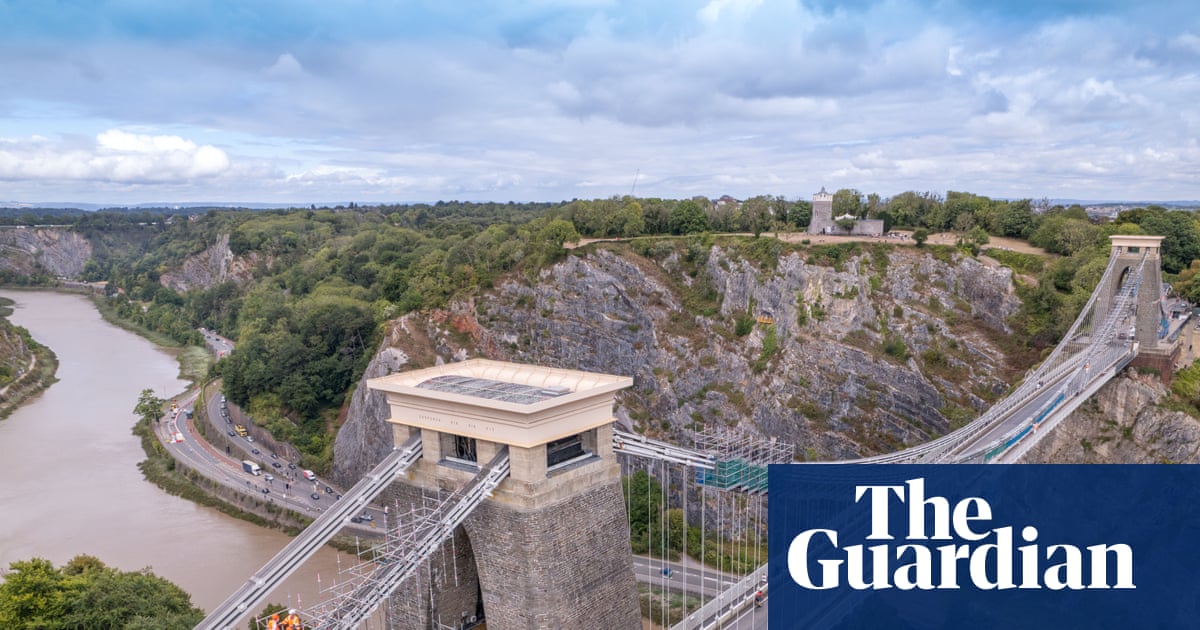It is a bit like that awkward job of painting behind a radiator – but on a vast scale and while perched high above a river gorge atop gently swaying scaffolding.
The challenging task of preserving and sprucing up Clifton Suspension Bridge’s wrought-iron chains, which needs to be done every 25 years, is in full swing.
“It’s certainly quite a project,” said Trish Johnson, the holder of the historic title of bridgemaster, who came up with the radiator comparison. “But the bridge is such an iconic structure, such a symbol of Bristol, and we can’t wait to see it sparkling again – it’s going to look great.”
The scaffolding moves with the bridge’s structure in the wind. Photograph: Adrian Sherratt/The Guardian
The Guardian was given a rare chance this week to clamber up the scaffolding set up around the 4,200 chains; it is light and flexible and moves with the bridge’s structure in the wind.
From the road and footpath over the bridge, the view is great; from higher up, close to the towers, it is spectacular. You can see the hills of north Somerset, Bath and Wales, and almost peer into Bristol City FC’s Ashton Gate stadium.
The platform the Guardian reached was about 100 metres (330ft) above the river close to the tower on the west side of the bridge that bears the motto suspensa vix via fit – a suspended bridge built with difficulty.
Isambard Kingdom Brunel’s stucture may have been built with difficulty but it has stood the test of time and still has 99% of its original ironwork. “It’s not like Trigger’s broom,” said Johnson, alluding to the road sweeper’s brush – which had 17 new heads and 14 new handles – in the sitcom Only Fools and Horses.
As the River Avon is tidal, the salty air means the bridge’s ironwork can corrode easily if not well-maintained. Photograph: Adrian Sherratt/The Guardian
The bridge was opened in 1864 – but the links are even older as they were recycled from the engineer’s original Hungerford footbridge in London when it was demolished.
The refurbishment work on the grade I Clifton Suspension Bridge began in April last year and should be finished by next spring. It is being carried out by the engineering contractor Taziker, which has previously worked on Abraham Darby’s Iron Bridge in Shropshire and Brunel’s Royal Albert Bridge, which links Devon and Cornwall. Taziker is also refurbishing Brunel’s intricate ironwork on the roof of Bristol Temple Meads station.
The flake-grey paint has to be applied painstakingly by hand because it is difficult to get the right thickness in the nooks and crannies with a spray. Specially made brushes designed for the Clifton chains have been created.
As the River Avon is tidal, the salty air means the ironwork can corrode easily if it is not well maintained. Three coats of even coverage are required. Another reason for not spraying is that drips and flecks must not find their way into the gorge, a site of special scientific interest.
The bridge’s motto, suspensa vix via fit, is engraved on the tower on the west side. Photograph: Adrian Sherratt/The Guardian
About 8,000 litres (1,760 gallons) of paint will be used and it will take 100,000 person-hours to complete the job. The project is costing £8m and is funded through the tolls collected by the Clifton Suspension Bridge Trust charity, which maintains the bridge.
Natalie Craig, the learning officer at the bridge, said workers of eras gone by would be amazed at the effort, especially the health and safety measures in place now.
“Way back then, they would balance on the chains to go up,” she said. “One of the things they would be asked when they went for a job is if they could walk up the chains. They wouldn’t be able to comprehend all the measures we have today but they’d be proud of how it is being looked after. Everyone loves the bridge.”
